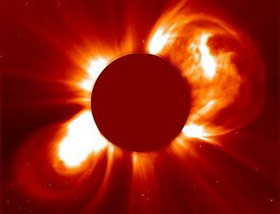New discovery about the formation of solar storms
 Scientists at Canada's University of Anberta said on May 26 that they could track the formation of a solar storm from its origin in the universe.
Scientists at Canada's University of Anberta said on May 26 that they could track the formation of a solar storm from its origin in the universe.
This finding could provide a "new tool" in predicting the weather in the universe.
The University of Alberta team of scientists led by physicists Jonathan Rae and Ian Mann used the data observed by the five satellites Themis observing the universe by the Canadian Space Agency (CSA) and the Agency US aerospace (NASA) launched from 2007, as well as a number of underground observation stations provide to determine the location of a solar storm.
Solar storms are a stream of charged particles released from the upper region of stars carrying electrons and protons at high energies, about 500KV.
The lines of charged particles emitted from the sun produce a magnetic field, about 6-10-9 teslab in size and pressed on the earth's magnetic field, causing the magnetic field to be pressed upward.
As the earth's magnetic field rises, the magnetic flux will change and produce an induced current against the Earth's magnetic field increase. This induced current can reach millions of acres of movement around the earth and cause a huge magnetic field to act on the earth's magnetic field.
In terms of the harmful effects of solar storms, scientists believe that the storm could disrupt power transmission systems, telephone waves, paralyze satellite devices and affect human health. Therefore, the determination of the point of formation of solar storm is very important for humanity to minimize the damage it causes.
Physicist Ian Mann said that Themis satellites will continue to monitor solar storms for another three years and this information will help his team forecast more accurately the weather in the universe.
- What is solar storm?
- Discover an asteroid outside the Solar System
- Dozens of strong storms and storms can pour into Vietnam
- Storms are the origin of planet formation
- Learn the secret of Mars formation
- Solar storm attacks the earth
- Typhoon is equivalent to one million tons of explosives causing Mars to be dry
- The Sun Storm caused many animals to get lost?
- Solar storms are stronger in the next 11 years
- New discovery about the formation of neutron stars
- New hypothesis about the solar system
- Solar storms are impervious to earthquakes
 Van Allen's belt and evidence that the Apollo 11 mission to the Moon was myth
Van Allen's belt and evidence that the Apollo 11 mission to the Moon was myth The levels of civilization in the universe (Kardashev scale)
The levels of civilization in the universe (Kardashev scale) Today Mars, the sun and the Earth are aligned
Today Mars, the sun and the Earth are aligned The Amazon owner announced a secret plan to build a space base for thousands of people
The Amazon owner announced a secret plan to build a space base for thousands of people